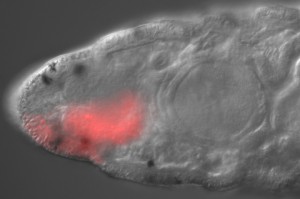As a complement to molecular studies in C. teleta, my lab is also interested in using fate mapping to learn more about development of C. teleta and spiralians in general. C. teleta develops by spiral cleavage, a highly stereotypical cleavage program that is found throughout the spiralians. This stereotypy allows homologous blastomeres
to be recognized across taxa even though their body plans appear diverse, thus
facilitating reconstruction of the evolution of structures.
 Previously, in my former post-doc lab, we mapped early blastomere fate (through 32 cells) in C. teleta by intracellular lineage analysis. This fate map has allowed identification of the blastomeres that generate most of the structures in the animal, including the brain and ventral nerve cord. This also allows for injection of reagents into a subset of tissues (e.g. the left side versus the right side of the brain). Furthermore, these cells can be followed in real time as the brain or ventral nerve cord develops and undergoes metamorphosis.
Previously, in my former post-doc lab, we mapped early blastomere fate (through 32 cells) in C. teleta by intracellular lineage analysis. This fate map has allowed identification of the blastomeres that generate most of the structures in the animal, including the brain and ventral nerve cord. This also allows for injection of reagents into a subset of tissues (e.g. the left side versus the right side of the brain). Furthermore, these cells can be followed in real time as the brain or ventral nerve cord develops and undergoes metamorphosis.


